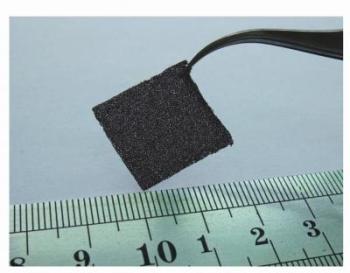A research team led by Hui-Ming Cheng, a Professor at the Chinese Academy of Sciences’ Shenyang National Laboratory for Materials Science, and Nikhil Koratkar, a Professor at Rensselaer Polytechnic Institute, has used graphene foam as a gas sensor to detect harmful explosive chemicals, paving the way for the commercialization of next-generation of gas sensors based on nanostructures.
 A new study from Rensselaer Polytechnic Institute demonstrates how graphene foam, as see here, can outperform leading commercial gas sensors in detecting potentially dangerous and explosive chemicals. Credit: Nikhil Koratkar
A new study from Rensselaer Polytechnic Institute demonstrates how graphene foam, as see here, can outperform leading commercial gas sensors in detecting potentially dangerous and explosive chemicals. Credit: Nikhil Koratkar
The research team used continuous nanosheets of graphene to produce the rugged and flexible gas sensor that has a sensitivity better than the existing commercial gas sensors. The nanosheet can form a foam-like framework having a thickness of felt and the dimensions of a postage stamp. The novel foam-like structure has all the unique properties of a single nanostructure and its macroscale and large size facilitates its workability.
The research team grew graphene over a nickel foam structure. After the removal of the nickel foam, the resulting product is a free-standing, large foam-like structure of graphene. The walls of the sensor made of foam-like graphene are consisted of continuous sheets of graphene with no interfaces or ruptures between the sheets.
During the study, the research team exposed the graphene foam structure to air containing trace amounts of nitrogen dioxide and ammonia. The nanostructure adsorbed these gas particles on its surface, which modified the nanomaterial’s surface chemistry and thus its electrical resistance. The team developed a sensing mechanism by measuring this alteration in electrical resistance of the nanomaterial to detect the trace amounts of various gases. The novel graphene foam gas sensor was able to measure continually the trace amounts of nitrogen dioxide and ammonia down to 20 ppm.
Detecting Gas with Graphene Foam at RPI (Prof. Nikhil Koratkar)
The new gas sensor has superior tear and wear resistance due to its high flexibility. Its high sensitivity is caused by its unique porous, three-dimensional structure that enables easier adsorption of gases on its large surface area. Its continuous nanosheet structure enables it to work as a single nanostructure with a macroscale size, allowing electrons to flow freely with minimum resistance, which in turn increases its sensitivity to gases.
The gas sensor can be cleaned easily by conducting approximately 100 mA current to heat its nanostructure to desorb all the gas particles. The gas sensor is a fully-reversible sensor, as this cleaning process does not affect its sensitivity to gases, and is a low-power sensor, as it eliminates the requirement of exterior heaters to perform the cleaning process.